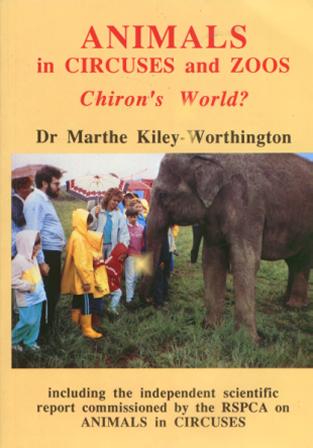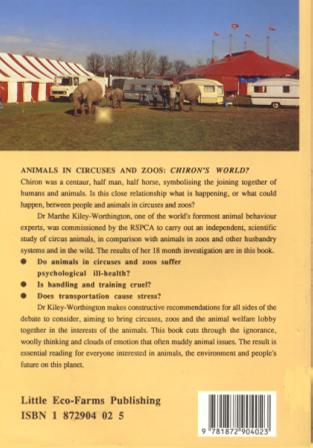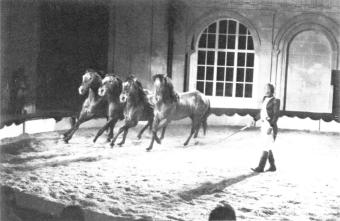



ANIMALS IN CIRCUSES AND ZOOS: CHIRONS WORLD?
Chiron was a centaur, half man half horse, symbolising the joining together of humans and animals. Is this close relationship what is happening, or what could happen, between people and animals in circuses and zoos?
Dr Marthe Kiley-Worthington, one of the worlds foremost animal behaviour experts, was commissioned by the RSPCA and UFAW (Universities Federation for Animal Welfare) to carry out an independent, scientific study of circus animals, in comparison with animals in zoos and in the wild. The results of her 18 month investigation are in this book.
Do animals in circuses and zoos suffer psychological ill-health?
Is handling and training cruel?
Does transportation cause stress?
After 3000 hours of scientific observation of animals and many visits to circuses and zoos, including training, travel and performance, Dr Kiley-Worthington concludes that, while there are improvements that must be made, circuses do not by their nature cause suffering and distress in animals. She states, "On balance, I do not think that the animals best interests are necessarily served by money and activities diverted to try and ban circuses and zoos either locally or nationally. What is much more important is to continue to encourage the zoos and circuses to improve their animal welfare along the lines recommended."
Arguing against animals and people having no contact (Animal apartheid), Dr Kiley-Worthington looks towards a symbiotic animal management system in circuses, zoos and elsewhere, so groups of animals and people can live and work together, respecting each others needs but each gaining from the relationships - CHIRONS WORLD.
MARTHE KILEY-WORTHINGTON, B.Sc., D.Phil., was one of the first ethologists to go and live with and study wild African animals, and to recognise behavioural problems of captive and domestic animals. She has done research and taught at the Universities of Makerere, Sussex, Pretoria and Edinburgh. Her work includes studies of many large mammals, animal welfare and training. Since 1971, she has been an Animal Behaviour consultant, and she also runs experimental Eco- farms, currently in Devon. She has three sons and is the author of five books and numerous scientific papers.
Dedication
To all the animals in circuses and zoos. May your lives be long and happy. May your human handlers and associates learn to understand and respect you better, and may the conditions under which you live improve.
By the same author:
The behavioural problems of farm animals (Oriel Press, Stockton 1977) The behaviour
of beef cattle, with S. de la Plain (Verlag Birkhauser, Basel 1983) The behaviour
of horses in relation to management and training (J.A. Allen, London 1987) Food
First Ecological Agriculture (in press, 1990)
ANIMALS
in CIRCUSES and ZOOS
Chirons World?
Dr Marthe Kiley-Worthington
Visiting Lecturer, School of Agriculture, University of Edinburgh and Animal Behaviour Consultant

Little Eco-Farms Publishing
Animals in Circuses and Zoos Chirons World?
Dr Marthe Kiley-Worthington Visiting Lecturer, School of Agriculture, University of Edinburgh, and Animal Behaviour Consultant
Photographs: David Jamieson; Marthe Kiley-Worthington; Roger Cawley (page 177: Mary Chipperfields elephants, breeding centre, Woburn)
Front cover photograph: an Indian elephant and the public meet at close, uninterrupted quarters at a circus.
Back cover photograph: a British circus encampment, with the elephants grazing, 1990.
Title page photograph: Horses in a circus performing the movements without any physical restraint. The next phase is perhaps without the presenter too!
Editor: Stephen Attmore
LITTLE ECO-FARMS PUBLISHING Distributed by Aardvark Publishing, 15 Wyldwood Close, Harlow, Essex CM17 OJD, England.
ãMarthe Kiley-Worthington 1990 All rights reserved. No part of this book may be reproduced, stored or transmitted in any form or by any means without the prior written permission of the publishers.
First published 1990 Second impression 1995 ISBN 1 872904 02 5
Printed in Great Britain by Bell & Bain Ltd., Glasgow
List of illustrations
Acknowledgements
Introduction
| Chapter 1 | Background | 12 |
| Chapter 2 | About Circuses | 23 |
| Chapter 3 | Are Circuses and Zoos Cruel? | 48 |
| Chapter 4 | Psychological ill-health: Distress | 63 |
| Chapter 5 | Do animals in circuses and zoos feel pleasure? | 95 |
| Chapter 6 | Handling and training, is it cruel? | 105 |
| Chapter 7 | The arguments against zoos and circuses | 143 |
| 1 Equal consideration for animals | 144 | |
| 2 Animal Apartheid | 149 | |
| 3 Should wild animals have special status? | 154 | |
| Chapter 8 | Arguments for zoos and circuses | 161 |
| Chapter 9 | Symbiotic animal management | 179 |
| Chapter 10 | Recommendations | 199 |
| Chapter 11 | Conclusions | 218 |
| Appendix 1 | Veterinary requirements of the Association of Circus Proprietors of Great Britain | 224 |
| Appendix 2 | Methods | 226 |
| Appendix 3 | Results of questionnaire to circus goers | 233 |
| List of circuses and zoos visited | 234 | |
| Bibliography | 235 | |
| Index | 239 |
List of illustrations
Acknowledgements
The RSPCA are thanked for producing the bulk of the finance for this project. The University Federation of Animal Welfare also helped financially. The Association of Circus Proprietors are thanked for their cooperation and individual proprietors for their hospitality, interest and trust. The ACP have also helped financially with the preparation of the work for publication. The Welcome Foundation helped finance my visit to the US.
I am deeply indebted to Barney and Sue Holden, my long-suffering research assistants; and Pete Gush who did all the computing and much typing. Their energy, enthusiasm and good humour in what were often difficult circumstances were invaluable.
Dr Mike Appleby helped with the statistics; Professor Wood-Gush (Applied Ethology, School of Agriculture, University of Edinburgh) is thanked for allowing me the hospitality of his facilities, and for critically reading the manuscript. Thanks also to Chris Rendle, Kate Rawls and Dr R. Ewbank (UFAW) who took time and trouble to read the manuscript. Professor Bernie Rollin, and other members of the Department of Philosophy, Colorado State University, Fort Collins, are thanked for inviting me, enlightened discussion and intellectual stimulation.
Finally, the rest of the finance and motivation was provided by the animals we work and live with.
Chiron was a centaur, half man and half horse. Centaurs symbolise the joining together of humans and horses (and other animals perhaps). Chiron was a wise, creative, prophetic centaur who mixed with gods and men... Centaurs were not only godly good persons, they also liked to have fun and were partial to wild, entertaining parties, and sometimes caused havoc... although Chiron was not involved in these, so they say!
Introduction
After the mist clears in the early morning at Liloni, if you are lucky and the day is clear, you can see the white snow-covered pudding top of Kilamanjaro some 250 or so miles away. Looking west from the verandah one looks down into the Rift Valley, and again on a clear day, herds of zebra, and wildebeest, kongoni, impala, Thompsons and Grants gazelles and groups of elegant giraffe can be dot-picked on the flat, hot plain. Closer to home, the little animated plums - the Kenyan highlands answer to the robin - leaping, chattering and cursing among the moonflowers and red hot poker plants in the garden. As Gye, my duiker friend, tiptoes across the Kikuyu grass taking an odd nippet of this and that; stepping adroitly over the cocker spaniel puppy, already spreadeagled on the lawn for his morning sun-nap.
An idyllic scene perhaps; it is the story of my raising in the clean, brisk air of Kenya. Inevitably such an upbringing - and this does not have to be something of the past - leads not only to an appreciation of the wonder and beauty of the living world, but to an intense realisation that we, homo sapiens, are part of it. My closest associates and friends were not other little kids, but the young and old of other species. As well as learning appropriate social behaviour from humans; individual horses, duikers, giraffes, dogs, cows, and bulls among others taught me (as they do many other children worldwide).
Inevitably my interests, as I grew, were not confined to humans and their activities, nore to admiring other species from a distance. They were obsessed by trying to learn more about all my different intelligent tutors. My quest took me to studying biology at school, to university in England, and back to East Africa to research and study waterbuck. Then back to Europe to learn more in universities about how animals behave and communicate, to farming, keeping and training domestic animals, to a consultancy on Animal Behaviour and to being commissioned by the RSPCA to study circus animals.
In 1965, Ruth Harrisons Animal Machines (99) began the awakening of the urban public to what had happened to animals in the country. The watershed in recent years was perhaps in 1976, when Peter Singers book Animal Liberation (21) was published. It hit a raw nerve, and set many people thinking.
Since then, animal welfare has grown in importance - even the Ministry of Agriculture has had to bend a sympathetic ear, and some small advances have been made for the animals benefit in farms and laboratories, at least, although stables, and kennels are very slow to change. In the last decade, boosted by public opinion, zoos have had to rethink what they are doing, why, and how.
The easiest target for the ever-growing band of Animal Welfarists has been circuses. They are a minority with no very articulate or powerful representation, and they have wild animals as well as domestic ones. They exist only to entertain, not to feed people or to save endangered species, and they make the animals do undignified things. It was, unlike fishing, or intensive farming, or certain types of pet keeping, a simple case: circuses were just wrong and ought to be stopped. However, it proved difficult to argue that the animals were physically in poor health, so it seemed that information must be accumulated on their psychological ill-health in order to strengthen the case against them.
The debates proved more complex than one supposed. To do a proper scholarly job it was not enough to restrict such an investigation to empirical scientific results. There is another fund of knowledge that must be bought to bear on the questions raised. The knowledge and understanding of those who live and work with animals should not be dismissed as just anecdotal or opinionated and therefore of no relevance.
Also, since the decisions are moral ones, the debates and ideas current among philosophers must be assessed carefully and the intellectual habit of critical thinking developed. Finally, we must assess the pros and cons of the existence of circuses and zoos on individual animals within them, on global and local ecology, and on other species, including human animals.
This work is an effort to put together accumulated knowledge from all these areas in order to asses what our attitudes should be to animals (vertebrates at least) and how we should live with them, use them and be used by them. It contains the result of the report written for the RSPCA in 1989, but it also examines all the various arguments in more detail.
Circuses and zoos are not the centre of multi-national industries.They serve people by only feeding their spirits (if at all), and have wild animals in captivity.
These are used as a springboard to examine what is or is not appropriate animal husbandry.
Do circuses and zoos inevitably cause prolonged suffering and distress to animals? Are they by their nature unacceptable, or is it just that some of them are badly operated? Are they worse than other animal husbandry systems?
Many people now argue that we should leave all animals alone, and not use them in any way. Is this either necessary, or desirable? What are the costs and benefits to the animal and the human of doing this? Should we not rather work out some criteria and codes of human conduct that would make association with animals morally, ecologically and ethologically acceptable for animal and human? If so, what would this involve?
I believe we can do this. All vertebrates, at least, should have a Bill of Rights. I suggest what should be included in such a Bill.
Make no mistake, Oh! Ye of little faith, I am on the side of my tutors, colleagues and friends, the animals. But this does not lead me to condone dis- association between humans and other animals, rather to promote mutually beneficial relationships between us all... symbiosis.
| Any
non working links, comments or suggestions please contact the webmaster:
kiley@polbox.com |
||
| This page is hosted
by Polbox On-Line Service http://www.polbox.com - free e-mail accounts and WWW pages |
||